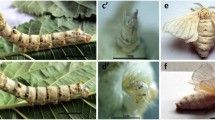Abstract
Mosaic silkworms were induced when the hybrid eggs of two strains with different egg color and larval markings were exposed to low temperature. Cytological studies were conducted to find out the relation between mosaic larval pattern and ploidy in reproductive cells along with demonstration of chromosomes in the mosaic embryos. — Mosaic eggs eith the characters of both the father and the hybrid were two types, one with large serosa nuclei (LN-mosaic) and the other with small serosa nuclei (SN-mosaic). The cytological studies demonstrated that LN-mosaic individuals were 2n/4n, while SN-mosaic ones were n/2n. In both types of silkworms, cell ploidy level in nuclei of synkaryon origin was two times that of androgenic ones. — From the results obtained in the present studies as well as in the previous studies, a possible mechanism of induction of mosaicism in silkworms by cold shock is contemplated.
Similar content being viewed by others
References
Astaurov, B.L.: Experimental alterations of the developmental cytogenetic mechanisms in mulberry silkworms: Artificial parthenogenesis, polyploidy, gynogenesis, and androgenesis. Advanc. in Morphogenesis 6, 199–257 (1967)
Goldschmidt, R., Katsuki, K.: Erblicher Gynandromorphismus und somatische Mosaikbildung bei Bombyx mori L. Biol. Zbl. 47, 45–54 (1927)
Hasimoto, H.: Experimental induction of mosaic individuals in the silkworm. Jap. J. Genet. 4, 113–114 (1929)
Hasimoto, H.: Induction of a new individual by the union of two sperm nuclei in the silkworm. Bull. Sericult. Exp. Sta. 8, 455–461 (1934)
Hasimoto, H.: Temperature treatment of silkworm eggs immediately after deposition and the sex ratio. Acta Sericult. 20, 11–13 (1957)
Katsuki, K.: Weitere Versuche über erbliche Mosaikbildung und Gynandromorphismus bei Bombyx mori L. Biol. Zbl. 55, 361–383 (1935)
Kawaguchi, E.: Der Einfluß der Eierbehandlung mit Zentrifugierung auf die Vererbung bei dem Seidenspinner. I. Über experimentelle Auslösung der polyploiden Mutation. J. Faculty of Agriculture, Hakkaido Imp. Univ., 38, 111–133 (1936)
Kawaguchi, E.: Genetic constitution of mosaic silkworms and its significance in the insect embryology. Jap. J. Genet. 14, 262–263 (1938)
Kawamura, N.: The early embryonic mitosis in normal and cooled eggs of the silkworm, Bombyx mori. J. Morph. 158, 57–72 (1978)
Kawamura, N.: Polyploidy and size of serosa nuclei and cells in eggs of the silkworm, Bombyx mori. J. Sericult. Sci. (Japan) 48, 28–36 (1979)
Takagi, N.: A simple technique to demonstrate the centromeric ‘heterochromatin’ in the mouse and other animals. Jap. J. Genet. 46, 361–363 (1971)
Takizawa, Y., Tamazawa, S.: A relation between polyploid and size of serosa cells of silkworm eggs induced by the supercooling method. J. Sericult. Sci. (Japan) 37, 248 (1968)
Tamazawa, S.: On the influences upon supercooling treatments to the silkworm eggs, Bombyx mori L. II. Androgenesis and mosaic induced by the low temperature treatments. Res. Bull. Univ. Farm, Hokkaido Univ. 20, 145–152 (1977)
Tanaka, Y., Kawaguchi, E.: On the triploid silkworm produced by the centrifugal force treatment. Jap. J. Genet. 7, 186–187 (1932)
Tazima, Y.: Induction of mosaic eggs in the silkworm (Bombyx mori) by means of high temperature shock. Jap. J. Genet. 15, 111–117 (1939)
Tazima, Y.: The Genetics of the Silkworm, pp. 146–175. London: Logos Press 1964
Tazima, Y., Onuma, A.: Experimental induction of androgenesis, gynogenesis and polyploid in Bombyx mori by treatment with CO2 gas. J. Sericult. Sci. (Japan) 36, 286–292 (1967)
Toyama, K.: Studies on the hybridology of insects. I. On some silkworm crosses, with special reference to Mendel's law of heredity. Bull. Coll. Agr. Tokyo Imp. Univ. 7, 259–393 (1906)
Author information
Authors and Affiliations
Rights and permissions
About this article
Cite this article
Kawamura, N. Cytological studies on the mosaic silkworms induced by low temperature treatment. Chromosoma 74, 179–188 (1979). https://doi.org/10.1007/BF00292271
Received:
Accepted:
Issue Date:
DOI: https://doi.org/10.1007/BF00292271




